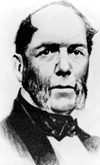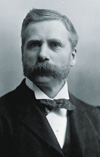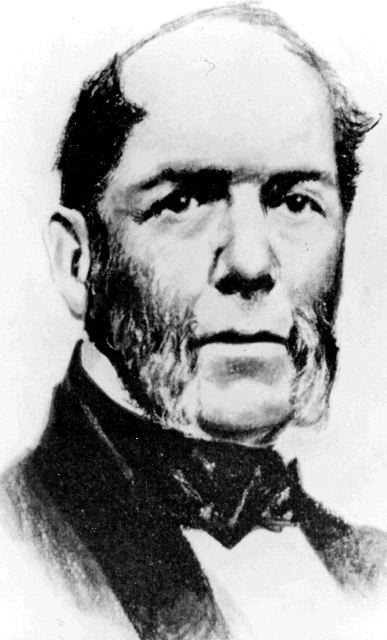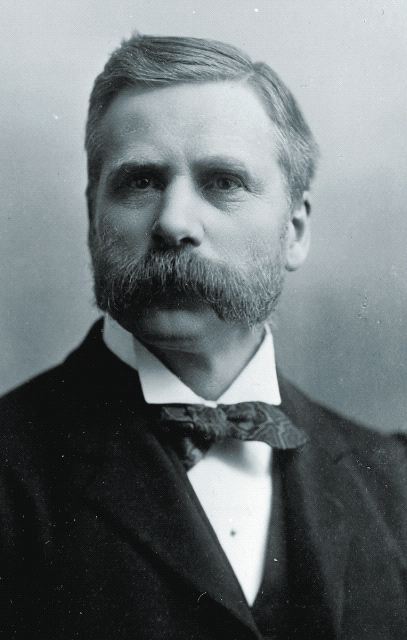The first discoveries

 (44 kb)In the summer of 1842, Dr. Abraham Gesner, New Brunswick’s first Provincial Geologist, crossed the northern part of this area, mainly to explore for coal. Passionate about geology, Gesner was also a physician, chemist and naturalist, and history remembers him as the inventor of kerosene. Following the Ristigouche River through the Dalhousie region, he decided to cross the estuary to get a better look at the cliffs on the Canadian shore. This natural curiosity would make him the first official discoverer of the Escuminac Formation and its fossils.
(44 kb)In the summer of 1842, Dr. Abraham Gesner, New Brunswick’s first Provincial Geologist, crossed the northern part of this area, mainly to explore for coal. Passionate about geology, Gesner was also a physician, chemist and naturalist, and history remembers him as the inventor of kerosene. Following the Ristigouche River through the Dalhousie region, he decided to cross the estuary to get a better look at the cliffs on the Canadian shore. This natural curiosity would make him the first official discoverer of the Escuminac Formation and its fossils.In the 1843 report from the Geology Service, he states, “...I found the shore lined with a coarse conglomerate. Farther eastward the rocks are light blue sandstones and shales, containing the remains of vegetables. (...) In these sandstone and shales, I found the remains of fish, and a small species of tortoise with fossil foot-marks.”
We now know that this little “tortoise” was the famous Bothriolepis, a common placoderm fish. It was the very first mention of Miguasha fossils in a scientific publication. Despite the circulation of this report, Dr. Gesner’s discovery received little attention, and the cliffs would remain anonymous for several decades to come.

 (36 kb)In 1879, the confederation of Canada had already united several provinces, including New Brunswick, and geologists from the Geological Survey of Canada could now explore this territory. In September of that year, Dr. Wheelock Ells unknowingly retraced Gesner’s steps. Surveying the south shore of the Ristigouche River, he decided to cross it to observe the Quebec stratigraphy more closely.
(36 kb)In 1879, the confederation of Canada had already united several provinces, including New Brunswick, and geologists from the Geological Survey of Canada could now explore this territory. In September of that year, Dr. Wheelock Ells unknowingly retraced Gesner’s steps. Surveying the south shore of the Ristigouche River, he decided to cross it to observe the Quebec stratigraphy more closely.Just like Abraham Gesner did 37 years earlier, Ells reported on the fossil specimens from Miguasha, although he evidently thought it was their first mention. This time the news spread rapidly and caught the interest of many geologists. Over the following summers, Ells returned to the area with other geologists, including Arthur Humphreys Foord and Thomas Chesmer Weston, to conduct the first organized expeditions. The fossils were taken back to Ottawa where they were examined and described by GSC paleontologists Joseph Frederick Whiteaves, who studied the fish, and Sir John William Dawson (rector of Montreal’s McGill University), who studied the plants.
Arthur Humphreys Foord discovered most of the fish specimens described by Whiteaves, a contribution for which he was honoured in the naming of the species Eusthenopteron foordi. Foord worked for the Geological Survey of Canada from 1872 to 1883 as a scientific illustrator, and later garnered fame in Europe for his work on Carboniferous cephalopods in Ireland.
At a time when religious dogmas were being called into question by scientific discoveries, Weston recounts a revealing anecdote in his book Reminiscences Among the Rocks. While hammering rocks on the Miguasha beach, he stopped to examine a fish specimen as an elderly woman approached. “Well now, it do like [sic] a mackerel,” she told him, “But if God made stone fishes for some wise purpose that the poor mortals can’t understand and ought not to meddle with, and Sir, it would be much better for you to leave them where the Lord placed them.” Weston attempted to explain the principles of fossilization to the woman, but as soon as he said the words “millions of years”, she became frightened and left.
The discoveries of Ells, Foord and Weston, and the research of Whiteaves and Dawson, set into motion a great scientific adventure for the Miguasha site that has lasted for more than 125 years.
Interview with René Bureau
![]() Open this page with video (7,9mo)
Open this page with video (7,9mo)
Note : For best viewing of this site, you will need this plugins: QuickTimeDownload QuickTime
Picture Description
René Bureau seeking fossils in the cliff. He discovers a specimen that he presents to the camera and then a reporter discusses the find with him.
René Bureau
It’s very rare that one finds such a complete specimen. Often the material is fragmentary, but in some cases, it is easy to glue three or four pieces together and still obtain a fine specimen.
Reporter
Tell me! Has the existence of the Miguasha site been known for some time?
René Bureau
Oh! The Miguasha site has been on record since 1842. One day, Dr. Abraham Gesner of the New Brunswick Geological Service was charged with exploring his province to possibly locate an extension to the coal bed. Slowly but surely, he made his way here to the outskirts of Dalhousie. Quite typically for a geologist, he asked himself what kinds of surface rock might be found on the other side.
He and his crew simply boarded a sloop and crossed over here. While exploring the area and walking along the beach, he came upon some fragments of fish fossils and what looked to be a turtle at the base of the cliff.
It was a Bothriolepis, but he was unaware of this. At the time, the species was unknown.
The following year, he published a report of his observations, but the report did not attract the attention of specialists.
The history of Miguasha had its ups and downs for 35 to 40 years, with occasional high points, until the arrival in 1879 of Dr. Ells of the Geological Survey of Canada. He conducted an exploration similar to that of Gesner, arriving ultimately on the outskirts of Dalhousie. He asked the same questions and took the same steps. He crossed over here and discovered the deposit. However, he benefited from the advances made by the Geological Survey of Canada between 1842 and 1879. Things had changed and evolved. Much more knowledge had been gathered. So, he was aware of the significance of his discovery. He gathered many specimens and immediately informed the Geological Survey of Canada. He returned the following year with men named Weston and Ford. They amassed collections that were sent to the Geological Survey of Canada. There the fossil fish were entrusted to Dr. Whiteaves who studied them and described his findings in publications. The fossil plants found with the fossil fish in the formation were entrusted to Principal Dawson at McGill University who, at this point, was well-versed in palaeobotany.
They issued publications that were distributed in scientific institutions such as universities in Canada and Europe. It was from this moment on, around 1882, that parades of strangers from many different foreign institutions were to come in waves to amass huge collections.
Site map | Feedback | Links | Sources | Credits
The first discoveries
<< The geology craze of the 19th century | Scientists come to Miguasha >>

Title: Abraham Gesner
Author: Not available
Sources: Parc national de Miguasha
Year: Not available
Description:
It was in 1842 that naturalist-geologist Abraham Gesner arrived at Miguasha and discovered the famous fish fossil beds of the Escuminac Formation. He wrote, “In these sandstones and shales, I found the remains of fishes, and a small species of tortoise with foot-marks.” It would take several more decades until it was realized that the fossil he mistook for a tortoise was in fact the bony carapace of the placoderm Bothriolepis canadensis.

Title: R.-W. Ells
Author: Not available
Sources: Parc national de Miguasha
Year: Not available
Description:
While on a geological mapping expedition in 1879, the geologist R.-W. Ells of the Geological Survey of Canada rediscovered the “Scaumenac Bay fossils”. He returned the following year with T.C. Weston and A.H. Foord. The latter collected most of the specimens that were used to make the first descriptions of Miguasha fish, and his contribution is acknowledged in the name given to the species Eusthenopteron foordi.


